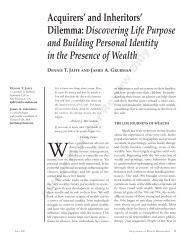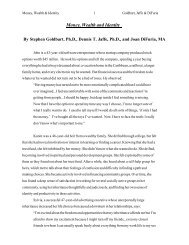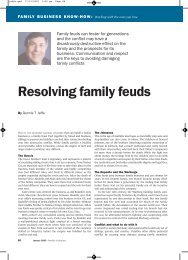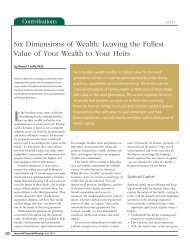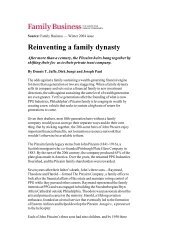Core Techniques for Effective Client Interviewing and Communication
Core Techniques for Effective Client Interviewing and Communication
Core Techniques for Effective Client Interviewing and Communication
Create successful ePaper yourself
Turn your PDF publications into a flip-book with our unique Google optimized e-Paper software.
<strong>Core</strong> <strong>Techniques</strong> <strong>for</strong> <strong>Communication</strong> article – Jaffe <strong>and</strong> Grubman Page 3<strong>for</strong>mation you can then glean, both factually <strong>and</strong>emotionally from the client’s perspective.Open-ended questions also cast a wide net butelicit in<strong>for</strong>mation in a more generic way. Examplesinclude “Can you tell me more about that?”, “I’dlike to hear more about that”, <strong>and</strong> “Can you go intomore detail about that?” They are in contrast toclosed-end questions that are either multiple choice,true/false, or yes/no. Questions like “how muchdo you think you’ll need in retirement?” or evenemotional questions like “were you angry aboutthat?” can be answered with one-word responsesthat can shut down conversation instead of openingit up. Closed-end questions are sometimes necessarybut they tend to pull <strong>for</strong> problem-solving<strong>and</strong> narrow a conversation rather than broaden itor keep it going. Most advisors are un<strong>for</strong>tunatelyexcellent at closed-end questions but struggle withopen-ended questions. Both door-openers <strong>and</strong>open-ended questions allow you to go wide <strong>and</strong>deep in gathering in<strong>for</strong>mation. They also are yourfall-back when you are not sure what to ask <strong>for</strong>next or when you feel unsure about what the clientis feeling or thinking about something. Perhaps themost useful yet least used open-ended question is“what else?” It’s amazing how often checking <strong>for</strong>“is there anything else about that?” uncovers morein<strong>for</strong>mation that would have been lost if not <strong>for</strong>pursuing this conversational <strong>for</strong>m of due diligence.Clarifying questions help flesh out a particulararea but without an attempt to problem-solve oruse the in<strong>for</strong>mation in any way. They are part ofgood interviewing because their main focus is <strong>for</strong>you to learn more <strong>and</strong> fully underst<strong>and</strong> an issue ortopic;; they help you go deep into an area. Examplesinclude “What is it about the previous financialplan that you didn’t like?” or “What did youmost like about your previous advisor that youwould want me to do in a similar way?” One cautionwhen using clarifying questions is that youmust resist the temptation to pursue each bit of in<strong>for</strong>mationyou get in response. Good clarifyingdraws out a lot of in<strong>for</strong>mation be<strong>for</strong>e proceedingto solutions. In contrast, premature jumping toproblem-solving means important in<strong>for</strong>mation liesunanswered or undeveloped, which can undercutthe success of your work.2. Communicating clearly about theprocess of advising.You are probably so familiar with the process of financialadvising you may <strong>for</strong>get your clients may not knowwhat is involved, what the sequence of steps may be, orhow deep <strong>and</strong> wide the conversation may go. There isa good chance your idea of what can or may happen inmeetings <strong>and</strong> what the client thinks will happen may bevery different. You <strong>and</strong> the client can be on such differentpages as meetings proceed that the result can becomic or tragic. The only way to overcome this is <strong>for</strong>you to take the lead in explaining <strong>and</strong> getting agreementwith the client about what will be done, when, <strong>and</strong>how.This is particularly true when a client wants to talkabout personal issues that bear on his or her financialdealings but feels anxious about doing so. On a practicallevel, one of your responsibilities is to clarify theguidelines about confidentiality, especially what will beshared with other family members of your primaryclient. <strong>Client</strong>s may be reticent if they are not clear aboutwhom you will share the in<strong>for</strong>mation with. Particularlywhen working with couples or next-generation familymembers of clients, you should be clear whether, howmuch, <strong>and</strong> what type of in<strong>for</strong>mation you may share if atall. Unless confidentiality is understood, you will getless c<strong>and</strong>id in<strong>for</strong>mation than you desire. Most often,however, clients will pause at the threshold of disclosingprivate in<strong>for</strong>mation simply because the in<strong>for</strong>mationis emotionally loaded <strong>and</strong> they may not be sure whetheror how to tell you about it themselves. They need toget com<strong>for</strong>table with you be<strong>for</strong>e they can begin toshare.You may have your own anxieties or judgments aboutdelving into the emotional realm. Many advisors assumethat, if something is very personal, they shouldnot ask about it <strong>and</strong> the client will not want to talkabout it. Yet good financial planning naturally brings updeep issues that must be dealt with v . Some advisorsrecognize the utility of finding out personal in<strong>for</strong>mationbut they never ask the client’s permission to getinto these matters, so it feels disrespectful, impulsive,or intrusive. If you as the advisor do not take the necessarysteps to move <strong>for</strong>ward into sensitive topicsproductively yet diplomatically, by mutual agreementyou both will retreat into safe territory. This may leadyou to avoid or mish<strong>and</strong>le the real concerns that motivatethe client, limiting the effectiveness of problemsolvingas well as the relationship.Advisors must there<strong>for</strong>e practice a certain kind of assertiveness,a communication style that blends inquiry—com<strong>for</strong>t with delving into the client’s concerns <strong>and</strong>emotions – with advocacy - sharing your expertise withthe client in appropriate ways. There are a number ofbooks on assertiveness skillsvi that describe techniquesto enhance communication. Relevant competenciesinclude the ability to speak directly <strong>and</strong> honestly, tolisten well in situations of stress or conflict, <strong>and</strong> toh<strong>and</strong>le those crucial conversations that need to occur.The goal is not to become aggressive, domineering, orblunt;; none of those is truly assertive. The goal is toapproach issues directly <strong>and</strong> know how to h<strong>and</strong>le them.
<strong>Core</strong> <strong>Techniques</strong> <strong>for</strong> <strong>Communication</strong> article – Jaffe <strong>and</strong> Grubman Page 4When clients show natural hesitation as you start todelve into personal issues or periodically along the way,“talking about talking” can clear the air, h<strong>and</strong>le anyhidden or lingering concerns, <strong>and</strong> pave the way intonew areas or deeper levels of the client’s life, whichdeepens your relationship with the client. There aretwo skills that go h<strong>and</strong>-in-h<strong>and</strong> in a multitude of situations:explaining the process of financial advising <strong>and</strong>then asking the client if he or she feels okay with proceeding:Explaining process involves providing a descriptionabout what you either would like to do in theinterview or are about to do. This gives a heads-upto the client about what can come next rather thansurprising the client. It also can reflect your desireto draw an area to a close <strong>and</strong> move on. Examplesinclude “Now that we’ve talked about your currentinvestments, I’d like to spend some time hearingabout your family situation so I can know who theimportant people are in your life <strong>and</strong> <strong>for</strong> planning,”or, “You said one of your major concerns isabout your son’s overspending. I’d like to ask youin more depth about that so I can underst<strong>and</strong> howwe may deal with that in your estate <strong>and</strong> financialplanning.” If the area you would like to pursuefeels like it may be personal or private <strong>for</strong> theclient, you can add recognition of this aspect bysaying “I realize this may feel somewhat private totalk about.”When explaining process, you need to add a companionskill which is so fundamental <strong>and</strong> obviousyet so often neglected that damage can be donewhen it is omitted. This is the skill of askingpermission of the client to go into private areasbe<strong>for</strong>e you plunge ahead. Rather than making anindependent decision to move into a delicate orpersonal area, you stop <strong>and</strong> say, “would that beokay with you?” or “would you be com<strong>for</strong>tablewith that?” This gives clients a genuine opportunityto grant permission to proceed to the next areaof the interview or to decline if they so wish. Itdemonstrates respect – <strong>for</strong> the client’s privacy, <strong>for</strong>their decision-making, <strong>and</strong> <strong>for</strong> their participationas an equal <strong>and</strong> collaborative partner in the relationshipwith you. Although the situation may certainlycall <strong>for</strong> the area of inquiry, you show respectby asking permission from the person being interviewed.And we all like to feel respected, especiallywhen it comes to our privacy.Explaining process <strong>and</strong> asking permission <strong>for</strong>ewarn theclient about what you would like to do <strong>and</strong> provideopportunity to either open the door or say no. Even ifthe client declines, you have demonstrated you will notintrude on the client inappropriately or unilaterally. Italso shows you are mindful that some of what you aredoing is personal.When clients know you will give advance notice aboutdifficult areas of conversation <strong>and</strong> they will have achance to accept or decline, the relationship feels safeyet has mechanisms <strong>for</strong> going deeper. And remember,just because the client declines to go in to an area oncedoesn’t mean you never broach it again. In twenty minutesor two years, the issues may be appropriate toraise again <strong>and</strong>, with greater trust or a change in heart<strong>for</strong> the client, he or she may now be more willing to gothere with you. Timing can be everything.3. Speaking the client’s language.Certain advisor behaviors can disrupt the developmentof trust. One of the most common involves speakingexcessively in professional jargon. Using jargon is oftenmistakenly assumed to enhance trust by demonstratingintelligence or experience, when in reality inappropriateuse of jargon can undermine it. “Impressingthe client with professional knowledge” does not necessarilybuild trust.Many advisors launch into technical explanations be<strong>for</strong>egetting to know the client or as a substitute <strong>for</strong>listening to or educating the client. Overreliance onjargon sends a message to the client, “this is about me,the advisor – my expertise, my underst<strong>and</strong>ing of themarkets, my ability to look good.” Being able to explainthings well in underst<strong>and</strong>able English so the client iseducated <strong>and</strong> included sends the opposite message that,“this is about you, the client – your involvement, yourunderst<strong>and</strong>ing, <strong>and</strong> your com<strong>for</strong>t.”You have to be judicious about how much jargon touse with a client, based on his or her level of financialsophistication, experience <strong>and</strong> knowledge. Studies haveshown that clients like <strong>and</strong> trust advisors who are greatat explaining things in natural language rather than withextensive jargon vii . With the wrong client, going intogreat depth about Monte Carlo simulations, alpha versusbeta, or complicated basis-point calculations risksthe client’s feeling stupid, discounted, or patronized.Like spice, a little jargon goes a long way <strong>and</strong> a lot isdistasteful. Being clear is not only an art;; it is a connection.It draws people closer <strong>and</strong> makes the client feelmore like a partner than a byst<strong>and</strong>er in the advisingrelationship.A useful method of approaching client communicationis to think not in terms of levels of jargon (from a levelchockfull of terms used on CNBC, Bloomberg, <strong>and</strong>Financial Times to the basic level of Today Show interviewswith financial experts) but rather to various languagesor fluencies of different types of clients. Someclients are fluent in your professional jargon, just as ifthey were advisors themselves. But many if not mostclients are much more fluent in the everyday languageof life, family, <strong>and</strong> money, not your world of finance.
<strong>Core</strong> <strong>Techniques</strong> <strong>for</strong> <strong>Communication</strong> article – Jaffe <strong>and</strong> Grubman Page 7Endnotes:i Anderson, Carol <strong>and</strong> Sharpe, Deanna (2008). Research: <strong>Communication</strong> Issues in Life Planning: Defining Key Factors in Developing SuccessfulPlanner-<strong>Client</strong> Relationships. White Paper, FPA Press.ii CFPBS (2005). Topic List <strong>for</strong> CFP Certification Examination, Addendum. Certified Financial Planner Board of St<strong>and</strong>ards, Inc.iii Grubman, J. <strong>and</strong> D. Jaffe (2010). <strong>Client</strong> relationships <strong>and</strong> family dynamics: Competencies <strong>and</strong> services necessary <strong>for</strong> truly integratedwealth management. Journal of Wealth Management, Summer, pp. 16 – 31.iv State Street Global Advisors <strong>and</strong> Knowledge@Wharton of the Wharton School (2007). Bridging the Trust Divide: Advisor Best Practices<strong>for</strong> Communicating Value <strong>and</strong> Discussing Fees, www.spdru.com, May.v Dubofsky, David <strong>and</strong> Lyle Sussman (2009). The changing role of the financial planner (Parts I <strong>and</strong> II). Journal of Financial Planning,August <strong>and</strong> September issues.vi Patterson, Kerry, Joseph Grenny, Ron McMillan <strong>and</strong> Al Switzler (2002). Crucial conversations: Tools <strong>for</strong> talking when the stakes are high.McGraw-Hill.;; Segal, Jeanne (2008). The language of emotional intelligence: The five essential tools <strong>for</strong> building powerful <strong>and</strong> effective relationships.McGraw-Hill;; Fisher, Roger, William Ury, <strong>and</strong> Bruce Patton (2011). Getting to Yes: Negotiating Agreement without giving in (revised edition).Penguin Press.vii Arends, Brett (2011). A tip <strong>for</strong> financial advisers: When possible, use English. Wall Street Journal, May 2.;; Grubman, James (2010).Choose your words. Financial Planning, November, p. 152.viii Colgan, Mark (2004). Financial planning <strong>for</strong> widows <strong>and</strong> widowers. Journal of Financial Planning, May issue, pp 54-62.;; Starnes, Steve(2010). Is your firm prepared <strong>for</strong> Alzheimer’s? Journal of Financial Planning, December issue, pp 62-68.ix A detailed description of the principles, utility, <strong>and</strong> procedures of active listening can be found in practice development materials atState Street Global Advisors practice development website, SPDR University. See materials at www.spdru.com by James GrubmanPhD: The Five Steps to Active Listening Success <strong>and</strong> The Financial Advisor’s Guide to Active Listening.



